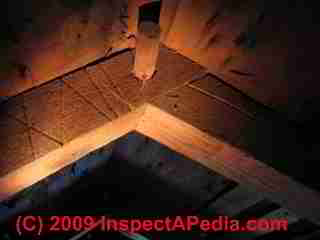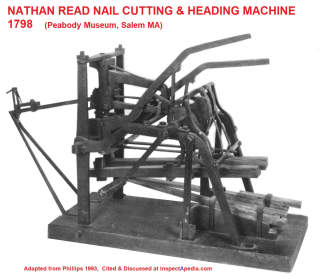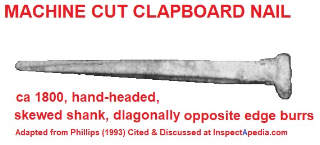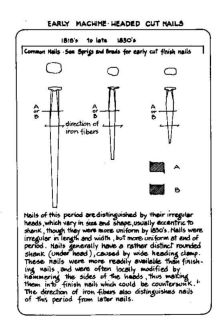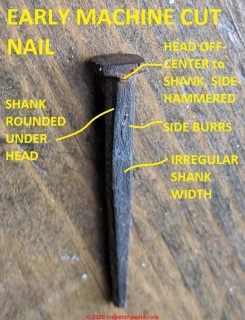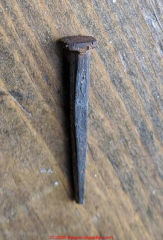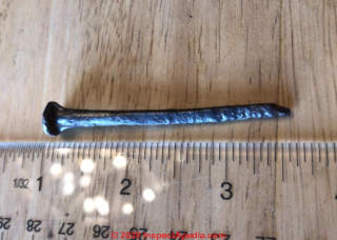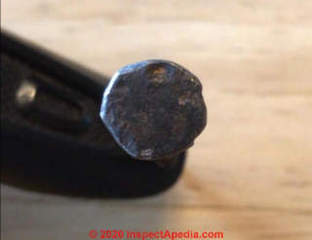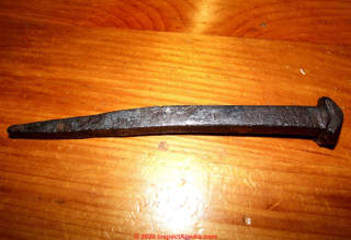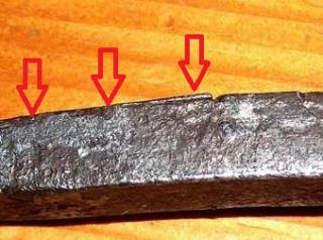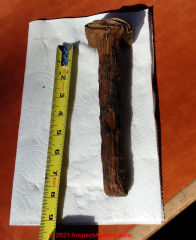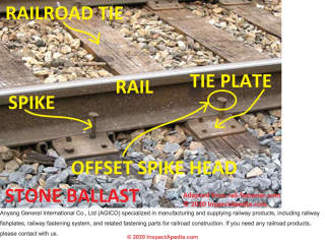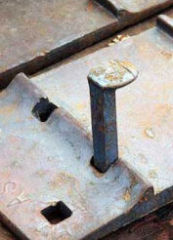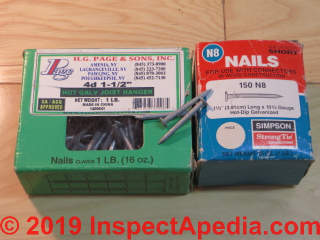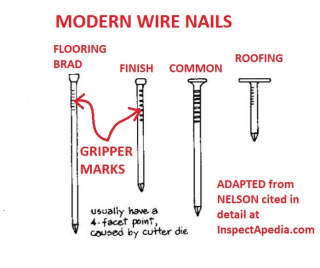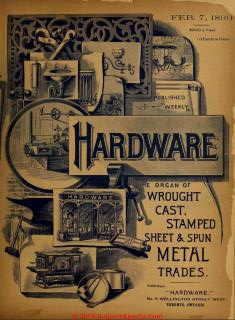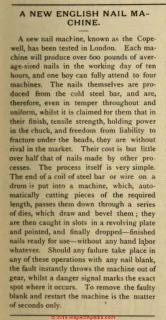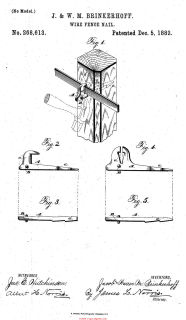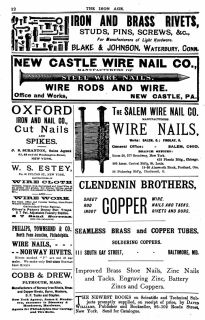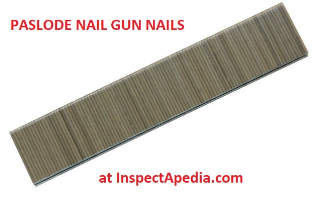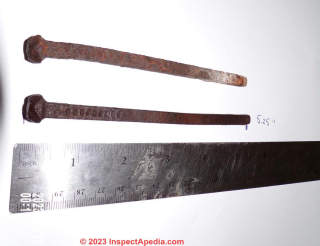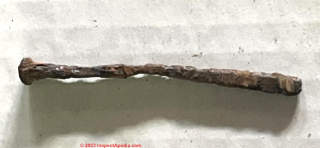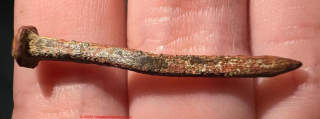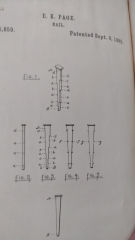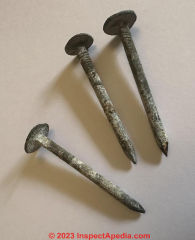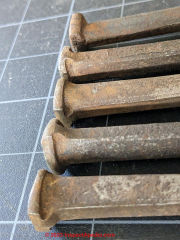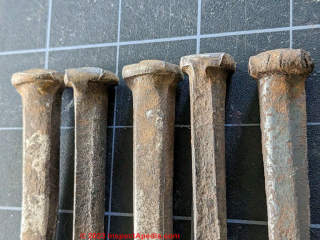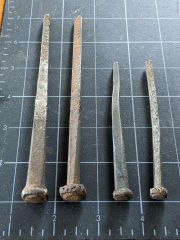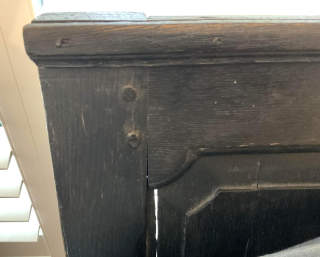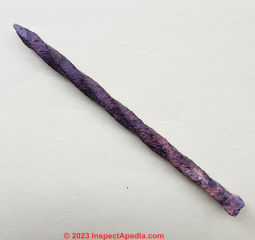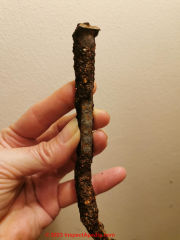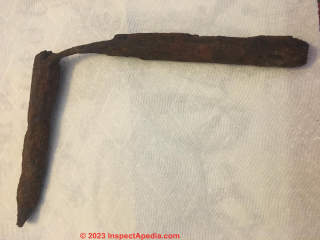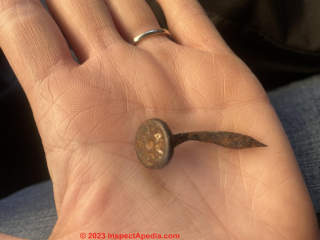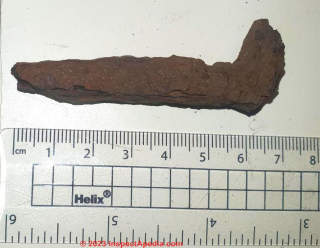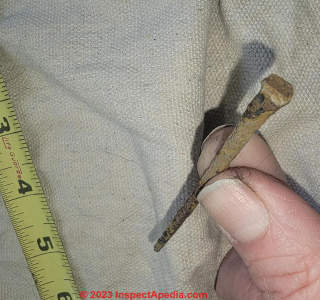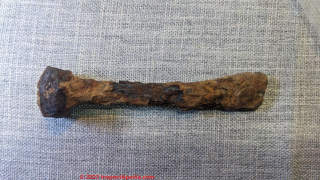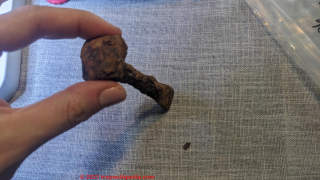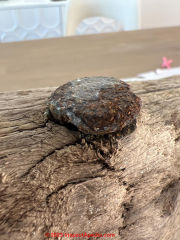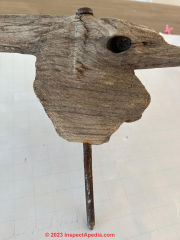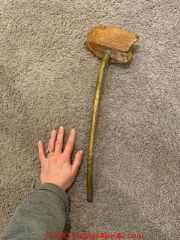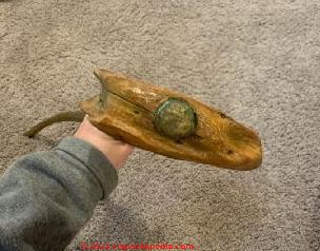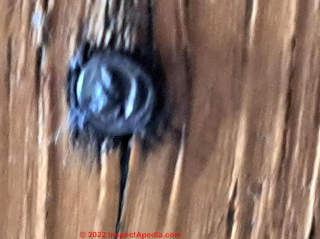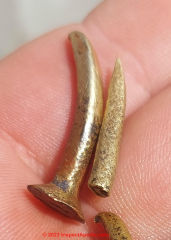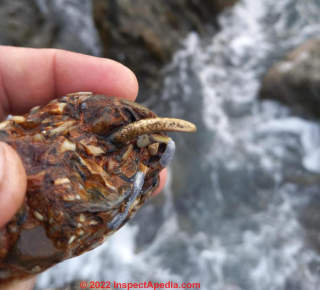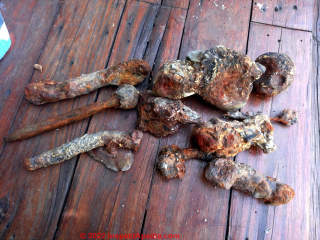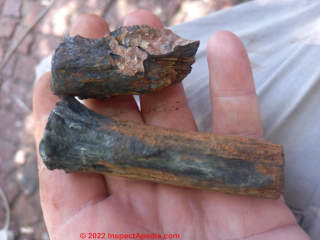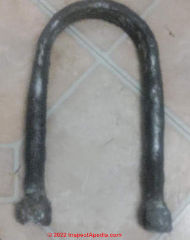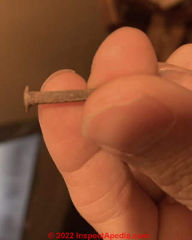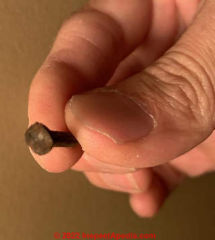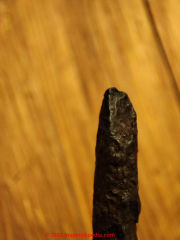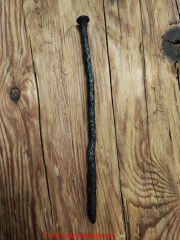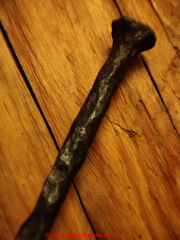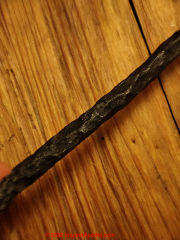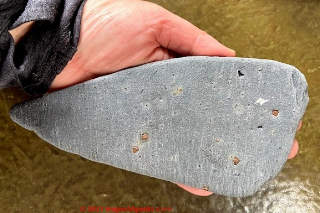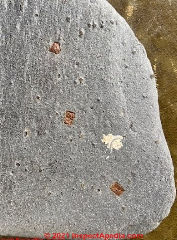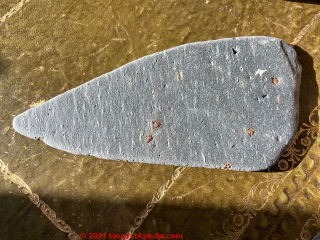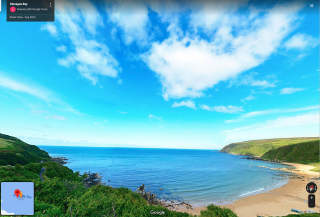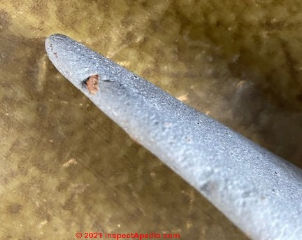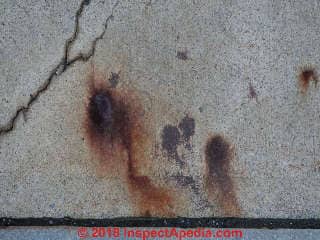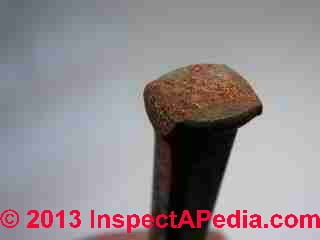 Chronological History of Nails
Chronological History of Nails
Antique Wooden, Forged & Cut Nail Age & Use - Home Page
- POST a QUESTION or COMMENT about determining building age by examining its nails & other hardware
Antique & modern Nails, including wood treenails, hand-wrought nails, cut nails, wire nails, are compared and described here.
We give a chronology: the history of nails, types & methods of fabrication, and we describe antique and modern cut nails focusing on tree nails, wrought nails, and cut nails used in wood frame construction or interior finishing or carpentry work.
We include useful dates for the manufacture of different nail types along with supporting research for various countries from Australia and the U.K. to the U.S. to New Zealand.
The history, number and types of nails is both interesting and enormous, even if we confine our discussion to just those used in the construction of buildings. We continue to add examples and photographs here and welcome readers to CONTACT US with contributions or suggestions.
This article series describes and illustrates antique & modern hardware: door knobs, latches, hinges, window latches, hardware, nails & screws can help determine a building's age by noting how those parts were fabricated: by hand, by machine, by later generations of machine.
InspectAPedia tolerates no conflicts of interest. We have no relationship with advertisers, products, or services discussed at this website.
History of Nails & Building Hardware
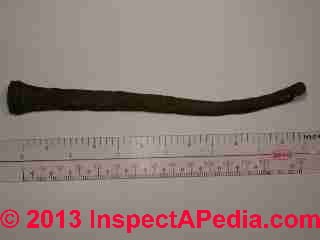 Nail Photographs & Nails as Indicators of Building Age
Nail Photographs & Nails as Indicators of Building Age
As a carpenter’s nails are divided into wrought nails and cut nails; so mankind may be similarly divided. Little Flask was one of the wrought ones; made to clinch tight and last long. - Herman Melville, Moby Dick.
An examination of nails and fasteners and other building hardware is a complimentary effort useful in determining the age of a building and its components.
[Click to enlarge any image]
A close observation of the type of fasteners used in a building is one of the most popular means of estimating its age.
The three types of nails found in North American construction include hand wrought nails, machine cut nails, modern round "wire" nails.
Nelson (NPS) and other nail chronologists point out, however that a wealth other details can describe the date of production and use of each of those three general nail types. In turn, nail details can establish the time of original construction of a building and the time of modifications to the structure.
In addition to nails, building material, wood saw cut marks, and other hardware details can further assist in determining building age.
The nail shown above in the photo and detailed further below was hand-made in the Northeastern U.S. before 1800 but could be still earlier.
To provide a chronology of the production and types of nails we first describe wooden nails or "tree nails" followed by a chronological list of useful dates for iron nails.
Wooden nails - Tree Nails or Treenails, Post & Beam Construction
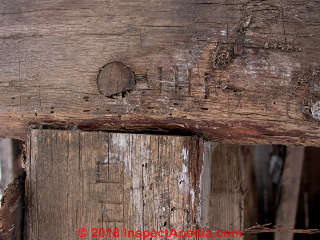 At AGE of a BUILDING, HOW to DETERMINE we note the following:
At AGE of a BUILDING, HOW to DETERMINE we note the following:
Post and beam construction (1700 - est. in North America): (timber framing) uses horizontal and vertical timbers that are connected (joined) using mortise and tenon joints pinned with wood pegs (treenails).
Timber frame construction initially used hand hewn beams, later manually or mechanically sawn beams cut by a pit saw. Later timber frame beams were sawn in mills using circular saws.
Timber framing using post and beam construction with mortise and tenon joint connections was used in Europe for at least 500 years before it was first employed in North America.
In our photo you can see the round sawn-off peg that secured the tenon of the lower vertical post into the mortise that had been cut into the horizontal beam.
The posts and beams were cut to size, mortises and tenons were cut, and the builders marked the corresponding joint components with numbers or letters - in my photo you can see the
I I I I
and
_
_
_
_
stamped into both the vertical post and horizontal beam to aid in assembly.
Below you can see the Treenail joining two rafters at the ridge of this 1790 home near Poughkeepsie New York.
By 1650 a typical timber frame building used multiple bents and girt beams, may have been more than one story tall, and included an exterior made of horsehair-reinforced cement stuccoed over hand-split lath.
More examples of uses of wooden pegs or treenails are at
- FRAMING MATERIALS, Age, Types
- FRAMING METHODS, Age, Types
- HEWN BEAMS & PLANKS
- SAW & AXE CUTS, TOOL MARKS, AGE
- SAW BLADE SIZE CALCULATED from SAW MARKS
- SAW BLADE MARKS to SAW SIZE CALCULATION ICT
A Tacky Little History of Iron Nails
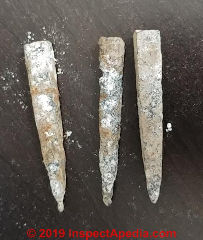 Nail Head & Nail Body Details Help Set Nail Age
Nail Head & Nail Body Details Help Set Nail Age
Photo: sprites, small headless hand-wrought nails, discussed in more detail
at NAILS & HARDWARE, AGE FAQs.
Adapting from various sources including Nelson's article cited below we give a rough chronology of types and uses of nails, focusing on North America but including other earlier nail production and use as well.
Earliest Nails - 300 B.C.
The Mansfield, Massachusetts Tremont Nail company's historical notes (cited below) indicate that nails have been made (by hand) dating back to 300 B.C.
Nails in the 1400s
The denomination of nail sizes based on the price per 100 nails (e.g. ten penny nails or 10d nails) dates from the 1400s.
In medieval England nails were made
into a great variety of special shapes
and sizes and sold by the hundred, e.g.,
8d (pence) per 100 nails.
From this
practice developed the classification of
nail sizes according to their price per
hundred, a system which seems to have
been established by the fifteenth century.
After that time nails slowly became standardized by size rather than
price.
In 1471 for example, "fippenynayl" were only 4d per 100.
In 1477
"xpenynayll" were only 8d per 100; and
in 1494 "sixpenynayle" were 5d per 100. (Nelson NPS)
Nails in the 1590s
The 1500s saw the first nail producing machines - First Nail Making Machines - 1590 Slitting Mills
The roots of producing nails by machine date from 1590.
Nails in the 1600s - 1900s: hand wrought nails
Hand wrought nails were used for construction and later more for decoration.
The scarcity of nails in colonial Virginia was reflected in a statute enacted in 1645 to prohibit settlers from burning down old buildings for their nails.
Some nails were made
in the colonies in the seventeenth and
eighteenth centuries, but despite this
local production very large quantities of
nails were imported during the same
period. (Nelson NPS)
Details are at NAILS, HAND WROUGHT
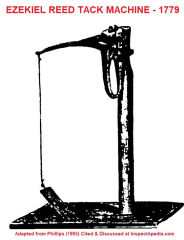 1766 - Iron Nails Used as Barter
1766 - Iron Nails Used as Barter
Although traditional Tahitian culture did not sanction extramarital sexual relations, within 48 hours of Wallis's arrival, Tahitian husbands and fathers were encouraging their wives and daughters to swim out to the Dolphin and offer the sailors sex in exchange for iron nails.
Aware of the brisk trade in iron, later explorers such as Captain James Cook brought supplies of nails and hoop iron with them to barter for freshwater, fish, pork, and vegetables.
Cook's visits [to Tahiti] in April 1769, August 1773, and August 1777 only heightened the islanders' desire for iron and other western goods. (Denver, 2013 Tahiti, p. 682-683).
For more on the history of nails used as barter and in trade see
1775-1783 Nails During the American Revolution
The colonists shifted to local production of nails and nail import from England was reduced or ceased altogether.
1779 First "Cut Nails" in North America
1779 - 1780 Hand-Operated nail cutting machines.
Ezekial Reed's 1779 Tack Machine,
(illustrated above, Phillips-1993) the first machine-made tacks,was operated by a foot treadle and was able to produce up to 3,000 tacks a day. Wedge-shaped iron blanks were cut by shears from a loop of strip hoop (such as used to construct wooden barrels).
The iron blank was placed tip-down in the jaws of the tack machine with the top protruding enough to be flattened by a hammer to form a head.
1788 - Adam Rogers machine to cut nails from iron hoops
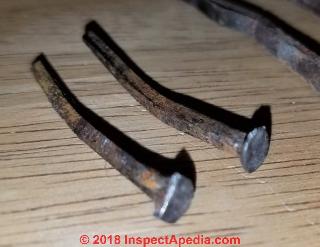 1772 - 1820: In North America early machine cut nails
1772 - 1820: In North America early machine cut nails
Dating from 1590 in England, as the earliest report of nail production, the earliest reported cut nails in America are reported to have been cut, essentially by-hand, by Darrow in 1772 (Federal Writers Project 2013) with other authors crediting the Wilkinson brothers somewhat later, ca. 1783 (Benedict 1883).
Nelson notes the first generation of cut nail manufacturing involved cutting all nails from common sides with heads hammered on as a separate production step.
The first nail making machines in North America appeared during the late 1700's - earlier than one might have guessed.
The slitting mill, introduced to England in 1590, simplified the production of nail rods, but the real first efforts to merchandise the nail-making process itself occurred between 1790 and 1820, initially in the United States and England, when various machines were invented to automate and speed up the process of making nails from bars of wrought iron.
Above are nails used to secure accordion lath - a plaster base found in a rural U.S. post-and-beam home in Wyoming County, New York.
These two nails are from different machines. Notice that the upper one has a rounded head. A closer look might show that the nail shank is constricted and rounded just below the head: marks from the vise that gripped the nail during the head-forming step.
The head on the lower nail is more-irregular.
More about the accordion wood lath in this building and our estimate of the building age are
1789 - U.S. Congress sets duty on imported nails
1790 - U.S. Congress passes first U.S. Patent Act - the second of two steps that encouraged development of nail making machines in North America.
1792 - Samuel Rogers (nephew of Adam Rogers) - expanded the hand-operated machine-cut nail operation.
These nails have shanks with two tapering and the other two parallel sides, cutting die burrs appearing on diagonally-opposite edges. (Phillips 1993). The cross-section of the nail shank is a "skewed rectangle" and the nail tips are rounded. Heads on these nails were hand-formed as a "T" or as a rose-faceted head.
1794 - Perkins Nail Cutting Machine. Jacob Perkins, inventor of a water-powered nail-cutting machine, began producing machine-made cut nails in 1794 and in 1795 received the first U.S. nail-cutting machine patent. (Phillips 1993)
Perkins' machine, powered by water rather than by hand would have been capable of producing a greater quantity of nails per day.
1798 - Read Nail Cutting Machine. Nathan Read produced cut nails at their Salem Iron Factory beginning in 1798.
Details about both of these inventors, their nail making machinery, and nail properties are in our separate guide to cut nails at
NAIL ID & AGE: CUT NAILS - photos of types of cut nails and details about determining their age where we describe early nail-making machines in North America and include English and U.S. patents for such equipment.
Our first illustration shows a skewed-shank machine-cut clapboard nail.
In our second illustration, (both adapted from Phillips 1993) note the rounded and narrowed shank just under the head as deformed when gripped in the machine vise to form the head (red arrow) and the irregular-shaped head (blue arrow) and also the rounded nail tips on both of these early machine-made nails.
1805 - present: nails made completely by machine
By some sources nails made completely by machine, including the nail head, appeared as sprigs and brads as early as 1805, and continue in use to the present.
(Nelson US NPS cited below.)
Really? Phillips (1993) reports that actually cut nails made entirely by machine are credited to Jacob Perkins- cited above.
- 1806 - Blanchard Tack Making Machine - 1806
Thomas Blanchard was born on June 24th, 1788, in Sutton, Massachusetts, near Worcester. His first invention was a tack making machine which he invented at age eighteen and perfected over the next six years.
This made production of tacks, which Thomas and his brother had been previously engaged in making, easier and more efficient at a rate of five-hundred per minute. - U.S. NPS cited below. - 1807 Read, Ezekiel nail cutting machine:
one machine producing both shank and head. Ezekiel Reed (un-related to Nathan) is credited with inventing the one-operation nail cutting machine in 1807. (Phillips 1993). - 1810 - 1820: cut nails
were made cut from opposing sides and used heads hammered on as a separate production step.
Cutting from opposing sides means that the shear cut that produced the nail was made from opposing sides of an iron or steel blank slab.
Take a look at the shear marks on your nail to see if they are both on one side or if they appear on opposing sides. See the "burrs" illustrated as adapted from Nelson in the citations at the end of this article.
[Click to enlarge any image]
- 1815 - late 1830s: crude machine made or machine cut nails, first machine made heads.
Illustration above: properties of early machine-headed cut nails, - US NPS, Lee Nelson (cited below).
Photo above: early machine cut nail photo, courtesy of reader J - 2020/05/23
[Click to enlarge any image]
Question: is this an early machine-cut nail?
I was recently repairing an old dresser I had gotten from a thrift store and found some very old looking square nails, which led me here.
They appear to be early machine cut nails based on your photos. Is my assessment correct?
Moderator reply:
The observation that your nail is irregularly tapered from below the head, getting wider, then narrowing again, suggests that it's an early machine-cut nail, perhaps roughly between 1815 - 1839 according to Nelson in our references.
NAIL ID & AGE: HAND FORGED NAILS
In the article above and also again at NAILS HAND-WROUGHT & REPRODUCTIONS we note from Nelson's research that ...
If your cut nail is irregular in shank width and has the "A" type side burrs it's likely to have been made before the late 1830s.
- 1820s - 1830s: crude machine made heads
Before the 1830s the iron fibres in machine cut nails ran across the nail shank, causing the nail to break off if the user tried to clinch it's protruding end.
For this reason, before the 1830s and where nail clinching was needed carpenters continued to use hand-wrought nails. (Nelson).
Cut nails made before the late 1830s will typically have:
- an irregular and possibly off-center head
- a head that may have been hammered to permit counter-sinking
- a shank of irregular width
- burrs that maybe on opposing sides of the nail shank depending on the cutting machine
Above: photos of Dan Nelson's early machine-made nail discussed just below.
Question: New England Nail estimated age 1810 +
2020/04/20 Dan Nelson said:
Hi,
I found this nail while metal detecting an old hayfield in northern Vermont.
The head is round.
The first quarter inch or so of the shank from the head is round-oval.
From there to the point, the nail is very square and tapered.
I do not understand why there are fins on the shank directly below the head. I have found coins I the area as far back as 1787.
I would like to be able to know the rough age of this nail. Thank you.
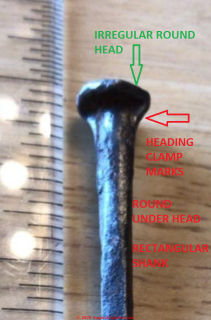
Reply: details of early machine made nails, rounded head & upper shank, rectangular lower shank
Dan,
Thank you for the helpful photos of your antique nail. My estimate of the age of your nail is 1830 or a bit older, with an "earliest" date of 1815.
As you are a Nelson, perhaps you will enjoy this companion article:
At NAILS & HARDWARE, AGE RESEARCH
On that page I cite Lee Nelson:
- Nelson, Lee, Nail Chronology As An Aid to Dating Old Buildings, Technical Leaflet 48. Nashville: American Association for State and Local History, 1968
and - Nelson, Lee H., NAIL CHRONOLOGY as an AID to DATING OLD BUILDINGS [PDF], U.S. National Park Service, Technical Leaflet No. 48. retrieved 2019/01/08, original source: npshistory.com/publications/nail-chronology.pdf
Looking carefully at the irregular-round nail head in your photo and the pinch marks just below the nail head, the earliest we could date this nail might be 1815-1830,
or in my OPINION, probably a bit later, as late as 1850. I think some early nail making machinery often had a longer life than ascribed by Nelson. In some communities, old nail making machine may have, for a time, continued in production alongside later, more-sophisticated machines producing more-rounded and more-uniform nails.
Made in the U.S. in the East, this is an early machine-made nail characterized, per Nelson, by its irregular-round head and the combination of a rounded shank and pinch marks from the nail heading clamp, transitioning to a rectangular shank for the remainder of the nail.
Your nail is large enough that it would not have been later modified (by hammering the head) to convert to a "finishing nail" that could be countersunk. Instead this 3 1/2" long nail would have been used as a structural connector.
In the U.S. the earliest manufactured nails (1790-1830) were operated by hand, later by water mills and still later by steam engines.
Because the rounded upper nail shank looks regular I suspect this is one of the later members of "Early Machine Headed Cut Nails" nails, 1830 - 1850 described by your namesake.
Nelson points out that these early machine-made nails were more readily available than machine-made finishing nails, and that they were often irregular in both length and diameter or width - something you cannot see when we have just one nail but that we might see if we were examining multiple nails from an old New England building.
A close look at the rectangular sides of the nail shank may show the remains of a long burr along the shank characteristic of early cut nails. The burr remains on the side of the nail that was cut from a flat iron plate that was opposite the descending shear blade.
Tapering was produced by "wiggling" the iron plate side to side as the shear descended to cut individual nails.
The irregular rounded head was made in a subsequent step by first clamping the nail shank so that the head could be compressed - hence the rounded shank with pinch marks on the upper part of the nail just under the nail head.
1810 - Present: Modern Machine Made Nails
Note direction of iron fibres in nails and spikes
Photos below: large iron spike found near Elmira, Ontario by Vern M shows laminar splitting along the length of the nail shank, giving an earliest date that some sources put at 1830.
The Perkins first cut nail machine patent (1795) was succeeded by an 1810 patent filed by the same inventor in England in 1810. That improved nail cutting machine produced nails with fibres along the length of the shank. (Phillips, 1993 citing English Patent No. 3365, application dated July 26, 1810; specifications filed January 26, 1811.)
So we have an earliest-date for nails like the one below, produced in the U.S., of 1810.
See more of our discussion on reader Vern's iron spike splits
at NAIL SPLITS & CRACKS vs AGE
Below: Tony's RR spike found on the Oregon Coast is an example of how rust patterns can suggest the direction of iron fibers in a nail. [Click to enlarge any image]
1832 - Present: Cut Spikes, Railroad Spikes
In our images above you'll notice that the head of these large railroad spikes sport an offset head. The larger lip of the offset head on these large spikes, also called crampons, was used to secure the bottom edge of the rail to the steel plate upon which the rail rests.
As the railroad spike is driven through the plate and onwards into the railroad tie or (sleeper), the combination of spike, tie-plate, and sleeper hold the rail in place in the stone-covered bed (ballast) of the railway.
Details are
1848 - Present: Original as well as Reproduction of Antique Nails
- 1848 - Present - Original-use and currently reproduction of antique nails, Tremont Nail Company
Details are at TREMONT ANTIQUE NAIL REPRODUCTIONS - 1850 - present: Modern wire-nails (nails that are round in cross-section) appeared in North America in the 1850s and continue to the present.
Round or "wire nails" are produced by cutting a round drawn wire into lengths to which a point and head are added by the machine.
Details and more images are at WIRE NAILS just below
1850 - Present: Modern Round Shanked / Wire Nails
Below, an example of modern round or wire nails, galvanized fasteners. These 4d 1 1/2" galvanized nails are designed for use with steel joist hangers.
- 1850 - Wire nails were produced in North America beginning in the 1850's, became the dominant nail in the U.S. by the 1890s, and continue in use to the present.
"Wire nails" refers to nails that were cut from a continuous pulled round "wire" of varying diameter. The wire is cut to the appropriate length for the desired nail length, allowing for the later machine-formed nail head and machine-cut nail tip.
In our illustration below you'll notice that modern "wire nails" show a series of parallel "gripper" marks along the upper end of the shank, just below the nail head.
Really:? Note that some earlier rectangular-shanked cut nails may also contain gripper marks under the head - formed by pinching individual nails, one-by-one, in a vise to permit the fabricator to use a hammer to form that nail's hand-wrought head. The gripper marks on thise earlier hand-headed rectangular shanked nails will generally be larger and of course those nail shanks won't be round.
Early wire nails were made first in smaller sizes.
If we exclude nails coated with a galvanized or other material, most modern wire-type nails will show parallel indentations across the top of the nail below the head, indicating the grip on the nail shank as the nail's head was formed.
- 1870 - Competition from Wire Nails (round) - 1870
The Birmingham industry expanded in the following decades, and reached its greatest extent in the 1860s, after which it declined due to competition from wire nails, but continued until the outbreak of World War I. (Sjögren 2013) - source: https://en.wikipedia.org/wiki/Nail_(fastener) retrieved 2018/06/15
Ezekiel Reed from Bridgewater Massachusetts developed the first machine that could cut a nail including its head in one operation.
In the U.S. the Parker Mills nail company was built in 1819 on the original site of the Parker Mills cotton mill that had been burned by the British during the War of 1812.
Above: Hardware Merchandising magazine article discussing a new English nail making machine, 7 February 1890.
[Click to enlarge any image]
- 1880's - special purpose nails,
eg. wire nails and barbed-wire fencing nails using hooked nail heads and sometimes, shank details that resisted inadvertent withdrawal from wood fenceposts but making future removal possible when wire fencing needed to be repaired or adjusted - shown above the Brinkerhoff wire fence nail patented Dec. 5 1882.
The nail head featured details that eased withdrawal of the nail using a hammer. - Brinkerhoff, Jacob & Warren M. Brinkerhoff, WIRE-FENCE-NAIL [PDF] U.S. Patent No. 268,813, December 5, 1882
- 1890 - High Volume Production of Cut Nails Continues - 1890
By 1890 nail making machinery had advanced to produce cut nails at high volume and low cost and at improved reliability. (Hardware Merchandising 7 Feb 1890)
The Parker Mills nail company became the Tremont Nail company that continues to produce traditional machine-made "cut nails" today. [1]
The development of machine made nails that could be produced in high volume was critical to this change in construction methods. But even in the 1930's and 40's nails were a meaningful cost of construction.
Above, a advertisement for wire-nails appearing in The Iron Age magazine, ca 1893.
- George, Washington. "Nail-staple for barbed wire." U.S. Patent 1,389,540, issued August 30, 1921.
1950 - Present: Modern Nail Guns & Power Nailers
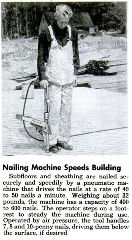
Illustration above: Popular Mechanics, March 1950, p. 96 describing the new "nail gun".
- 1950 nail guns in use in wood frame construction.
Modern round or wire nails dominate nail use in conventional framing and construction, actually replaced by nails formed to work in power nailers or "nail guns" for much wood-frame construction.
The nail gun was designed by Morris Pynoos, a civil engineer by training, for his work on Howard Hughes' Hughes H-4 Hercules (known as the Spruce Goose). The wooden fuselage was nailed together and glued, and then the nails were removed.
The first nail gun used air pressure and was introduced to the market in 1950 to speed the construction of housing floor sheathing and sub-floors.
With the original nail gun, the operator used it while standing and could nail 40-60 nails a minute. It had a capacity of 400-600 nails. - Wikipedia, Nail Gun, retrieved 2019/01/09, original source: https://en.wikipedia.org/wiki/Nail_gun
Illustration below: Paslode nail gun nails sold in strips are still "wire nails" but are no round in cross-section.
- 2019: modern nail guns.
Modern nail guns are sold in models that operate by compressed air, electricity, or gas cartridges. Manufacturers of nail guns in 2019 include at least the following nailer brands: A.D.I. Atachi, aka ADACHI, AEG, AirPress, Bostitch, DeWalt, Heico,m Hitachi-Koki, Makita, Milwaukee, Paslode, Rigid, Senco, Spit-Impex (concrete nailers), Sumake,
Paslode, a division of Illinois Tool Works, is one of a number of manufacturers of modern nail guns, sold in both cordless and pneumatic (air powered) models. Paslode was founded by J.W. Leslie in the U.S. in 1935.
Supporting Information to Estimate the Age of a Nail
Nails cannot alone give the exact date of construction of a building because the nails themselves may have been made considerably earlier or even re-used from a still-older construction. But nail age can suggest date boundaries for the construction at a site.
In guessing the age of a nail or other hardware it is very helpful if you can tell us
- Country and city of the building or site where the nails were found
- Age of the building and/or the site if the nails were not in a building or building component. Documents and records providing evidence of the date of construction of the building or site are the most-reliable dating or aging source.
- Age of buildings in the same area where similar nails are found
- Technology of production of a specific nail combined with history of the availability of nails produced by a given technology in the area.
For example in the U.S. machine made nails would have been first most-abundant on the east cost, spreading more slowly across the continent to the west, probably with some nails arriving by ship on the west coast. - Nail metal and nail coatings, e.g. first use of galvanized coatings, use of aluminum nails, copper nails, stainless steel (all modern) vs. wood and iron.
- The mixture of nail types in the building help identify original construction, modifications, additions
- Proximity to water, to industrial sites, other possible nail sources
- Nail dimensions, or size, and style (include a ruler in the photograph) can indicate the nail's intended use
- Presence of any surrounding material, wood, cloth, etc. where the nail was used.
- Presence of surrounding artifacts that help date the structure
- Wood lumber or trim or other nailed material species and cutting details can help determine building age and nail age too, though wood beams and planks from an earlier building may also have been re-used in a later one.
See SAW & AXE CUTS, TOOL MARKS, AGE - We also look closely at the nail iron itself for splitting, machine-cut edges, etc.
Watch out: Documentary sources
should take priority whenever possible, and
other artifacts should be used as supportive
evidence. (Adams 2002) as cited
at NAILS, AGE & HISTORY
Watch out: keep in mind that the date of manufacture as well as the date of actual use of nails varies significantly by country and even smaller areas, so the physical location and context of the nail's use are important in understanding its probable age.
If we know when a type of nail first became available in the area where it was found or used and if we know when later machine made nails were available in the same area that can set an earliest date for a particular nail.
Hand Wrought Nail Details
Details of Hand-wrought nails used in North America in the 17th, 18th, and 19th century in American building construction as well as modern hand wrought nail reproductions are now found
at NAILS HAND-WROUGHT & REPRODUCTIONS
Research on History of Hand Wrought Nails, Cut Nails & Wire Nails
This section has moved to NAILS & HARDWARE, AGE RESEARCH
where we provide photos, text excerpts & research citations for the history of production and use of nails for various countries including Australia, India, the U.K., Scotland, Wales, The United States, and New Zealand.
Reader Q&A - also see the FAQs series linked below
On 2023-08-31 by InspectApedia-911 (mod) - research on location where old nails are found yields information
@Jack E. DeMuynck, Jr.,
That's interesting indeed and it's a nice example of doing a little bit of leg work to add context that's helpful when we're trying to understand the age and history of an antique nail or other fastener.
To keep us posted on what else you find
On 2023-08-25 by InspectApedia Publisher (mod)
@Jack E. DeMuynck, Jr.,
Added comments: the straight, not-tapered shank and those large indentations that you confirm are clamp marks all argue for a early hand-forged spike.
The procedure commonly included clamping the forged shank into a vise in order to permit hand hammering to form the shank head. You should see that the heads on spikes in this set are each a bit different.
On 2023-08-25 by Jack E. DeMuynck, Jr.
They are clamp marks. Can you give an estimate when they may have been made? Thank you, Jack
The quarry they came from I suspect was an early cement aggregate, perhaps lime extraction site. The town it may have supported Amarillo, Texas was established around the turn of the 19th century.
Thanks for the reply. I'll work at getting you a Google earth location. You've done good research.
...
Location as found on Google Earth: Latitude 35.2289732 Longitude -101.919184
Again thanks for your interesting work. Next time I'm in the area I plan to research deeds and newspapers circa 1900. Jack
On 2023-08-23 by InspectApedia Publisher (mod)
@Anonymous, Jack:
Look like structural spikes, perhaps with hand-finished heads.
Take a close look at the upper shank markings: are those letters or clamp marks from a machine?
On 2023-08-23 by InspectApedia Publisher (mod) - nails found near Amarillo Texas Quarry
@Jack E. DeMuynck, Jr.,
Sure, glad to help. Here are some suggestions.
1. If we can assume that you have access to the nails in question, I suggest comparing the nail features, in detail, with the old nail features discussed above on this page.
2. Compare your nails with the nail features outlined also at
NAIL AGE DETERMINATION KEY, https://inspectapedia.com/interiors/Determine-age-of-old-nails.php
3. Review the detailed history of the Amarillo Texas quarry and thus you'll have an idea of the types of buildings or other structures - for which you've already posed an interesting guess: chutes for loading wagons and trucks.
The nail size is probably the first clue to its probable use as it's easy to separate smaller nails that secured boards from larger spikes that would have been used in structures.
it's the note of hand-wrought features that you might find particularly interesting.
Where is the quarry about which you inquire?
Are you referring to the Alibates Flint Quarries - whose history is ancient - as well?
Or have you researched activities that gave Quarry Street its name? Quarry Street runs between Yucca Ave. and Cliffside Road, those intersecting North Western St. off of I 335 northwest of Amarillo.
On 2023-08-23 by Jack E. DeMuynck, Jr.
I'm looking for information about some nails that where recovered from an old Quarry located near Amarillo in Potter County, Texas. The nails were used at what appeared to be a loading site and secured rough lumber that provided aggregate chutes for wagons and early trucks. Thank you, Jack
On 2023-08-12 by InspectApedia Publisher
@From Cape Cod MA,
nice old rusty nail or spike - interesting that it's more rusted in mid-shank than at head or tip. Might tell something of its use and history.
On 2023-08-12 by From Cape Cod MA
Look what I found!
On 2023-07-20 by InspectApedia DF (mod) - nail found at early Colonial site
@Paulo PS,
Our best and most complete advice are in the steps given at
NAIL AGE DETERMINATION KEY
(live link in the Recommended Articles list on this page)
In essence, when estimating the age, properties, use, and history of a metal fastener like a nail, spike, or screw, we look at
1. the item itself for clues about how it was made, of what materials, and in some cases iron fibre direction that can bracket age of manufacture
2. contextual clues: what we know from surrounding materials, location, history of the area, etc.
On 2023-07-20 by Paulo PS
I found a square nail on early colonies site it is not ferrous I suppose it's made of copper by the color can you please estimate the age, thank you
On 2023-07-08 by InspectApedia Publisher (mod) - Nail from U.K. Riverbank
@Tina F,
That's certainly an unusual "nail" with that thick squared head and flat-sided tapered shank. It looks to me like bronze, not wood, but of course we've got just a photo to go-on.
The point is sharp and tapered to be driven - that would not be characteristic of wooden peg or treenail such as we describe in several links given above on this page where we discuss tree-nails or "treenails" and wooden pegs.
Try scratching on one side to see if you expose brighter metal.
On 2023-07-08 by Tina F
Hello Can you please take a look at the attached photo. I found it on a river bank in the UK . It is 5 inches long and feels like wood definitely not metal. It’s an impressive nail and I would like to know where it may have come from and how old it is. Thank you
On 2023-06-22 by InspectApedia DF (mod) - age of a thin 15-inch long nail
@Matt M,
You will find our most-complete advice on guessing age at
NAIL AGE DETERMINATION KEY
https://inspectapedia.com/interiors/Determine-age-of-old-nails.php
In essence, as you’ll read there, when estimating the age, properties, use, and history of a metal fastener like a nail, spike, or screw, we look at
1. the item itself for clues about how it was made, of what materials, and in some cases iron fibre direction that can bracket age of manufacture
2. contextual clues: what we know from surrounding materials, location, history of the area, etc.
On 2023-06-22 by Matt M
Anyone know any info please..about 15 inches long
On 2023-06-10 y InspectApedia DF (mod) - split resistant nail patent by Page
@David Fox,
Thank you for the question and the reference to the 1885 Page patent.
For other readers, you can see this patent disclosure also at
Page Edwin K., NAIL, [PDF] U.S. Patent No. 325,859., September 8, 1885.
https://inspectapedia.com/interiors/Page-Patent-US325859.pdf
Excerpt:
My invention relates to the wedge-shaped nail in common use by builders, ordinarily cut from a plate, and two of its sides parallel, with the other two sides slightly tapering; and it has for its object to produce a nail which may be driven indiscriminately with either its parallel or tapering sides at right angles with the grain of the wood without splitting; and it consists in forming a series of cutting-teeth on the two opposite and tapering sides of the nail, sides parallel with the grain, the cutting-teeth will sever the grain and form a passage for the nail, preventing the splitting of the wood;
and my invention further consists in the formation of the nail with such cutting-teeth and Figs. 4 and 5 are views showing mode, it shows an elevation of the nail in common use. with parallel sides between the cutting-teeth,
so that the back of the teeth may be support ed, and so the wood will press more closely against the sides of the nail after it has been driven.
Interestingly this patent was cited almost 100 years later in
Schroeder, Norman, Irving Ahlbeck III, Bradley Schroeder, and Steven Stanwick. "Fluted nail." U.S. Patent 4,781,508, issued November 1, 1988.
We have not found records of the production of the Page patented nail but I have seen some cut nails with barbs and staggered edges, two of Page's designs, and certainly the idea of modifying the nail shank to improve its withdrawal resistance was extended to many modern nails such as the ring-shank on drawn wire nails.
Let's keep alert for these Page nails showing up in antique structures.
On 2023-06-10 by David Fox
I recently acquired a nail patent by inventor Edwin Page, patent number 325859. It's for a stepped nail design as shown in the attached image. Does anyone know if these nails were every actually produced and used?
On 2023-05-28 by InspectApedia DF (mod) - getting down to brass tacks age
@Penny,
Our most complete advice on guessing age is at
NAIL AGE DETERMINATION KEY
https://inspectapedia.com/interiors/Determine-age-of-old-nails.php
In essence, as you'll read there, when estimating the age, properties, use, and history of a metal fastener like a nail, spike, or screw, we look
1. at the item itself for clues about how it was made, of what materials, and in some cases iron fibre direction that can bracket age of manufacture
2. at contextual clues: what we know from surrounding materials, location, history of the area, etc.
Continuing: is that a round nail shank that we see in your photo? If so this is a relatively modern nail, not a hand forged one.
On 2023-05-27 by Penny
Hi, found this on the beach in Whitstable, would love to know a rough date. It’s material I believe is brass
On 2023-05-15 by InspectApedia DF - modern wire nails were first produced in the 1850s
@David Walsh,
Galvanized roofing nails were certainly around in the 1930s in the UK.
As you can read above in this article, modern wire nails such as yours were first produced in the 1850s. Beyond that, in order to more accurately date your building, you'll need to look at other contextual clues.
Many of these are listed above in the section titled:
Supporting Information to Estimate the Age of a Nail
This article series, with many of the live links listed above in the Recommended Articles list, explores further the age of nails and hardware.
You may be interested in the History of Nails in the U.K. section found in the article titled:
NAIL & HARDWARE, AGE RESEARCH
On 2023-05-15 by David Walsh
I am trying to date a garage in the UK. There is an argument it is 1930s, however looking at the timber specialists think much later. Here is a picture of the roofing nails used for the clay tiles, could anyone shed some light on the potential date?
On 2023-05-08 by InspectApedia Publisher
@Cameron T.,
Yes, though some of them have earlier style heads added as a separate step.
"Machine" includes hand-operated machinery.
I may be mistaken but to me [DF] your closeup photo of nail heads looks like a different collection. Newer.
I think I see parallel ribs across the nail shank close to the underside of the nail-head. Those would be grip marks from "modern" nail making machinery that has been in use for the last 100 years.
On 2023-05-08 by Cameron T.
Here is a picture of the heads. These are 6-7/8" long.
On 2023-05-08 by Cameron T.
Hi -- Got these at an estate sale. I was wondering if they are early machine cut nails. They sure feel great in the hand.
On 2023-04-07 by InspectApedia Editor - how old is my UK settle?
@Anonymous,
While treenails and wooden pegs may be used in building construction and window and door construction or in the construction of furniture as well even in modern buildings, usually that's certainly before 1900.
The range of use by geography and time is in my opinion so broad that we need to add contextual clues when guessing building or UK settle age rather than just looking at one component.
Those clues are given starting at
AGE of a BUILDING, HOW to DETERMINE - home
(live link below in Recommended Articles list)
Perhaps you can post further photos such as of other hardware, saw cuts or marks on lumber or timbers, type of framing connection, and other building features that we describe there.
On 2023-04-07 by Anonymous
is it possible to estimate the age of our UK settle with timber nails?
On 2023-04-01 by InspectApedia Editor - modern, machine-made, spiral nail
@Steve,
That's a modern, machine-made, spiral nail.
The spiral is intended to improve withdrawal resistance.
It looks as if much of the nail head has rusted away.
On 2023-03-31 by Steve
Is this modern or antique? The head is not perfectly round and squarish
On 2023-03-19 by InspectApedia Editor -rusty spike found at Brighton UK beach
@Lesleyburdetttaylor,
You will find our most complete advice on guessing age at
NAIL AGE DETERMINATION KEY
(live link below in Recommended Articles list)
where we discuss clues from the nail itself as well as the use of contextual clues.
On 2023-03-19 by Lesleyburdetttaylor
Found whilst metal detecting on the beach in Brighton UK. It's 8" long. Any ideas please?
On 2023-02-21 by InspectApedia Editor
@Al Diaz,
Please see our reply to reader Jenn D just below. There we give the link where we have our best and most complete advice on dating this type of hardware.
Note our discussion there about iron fiber direction, size, and other contextual clues.
On 2023-02-21 by Al Diaz
Is this a nail or spike . How old can it be found it on the beach front the conference house Staten Island NY
On 2023-02-18 by InspectApedia Editor - use contextual clues to help determine age of hardware
@Jenn D,
Our best and most complete advice are in the steps given at
NAIL AGE DETERMINATION KEY
(live link below in Recommended Articles list)
In essence, as you’ll read there, when estimating the age, properties, use, and history of a metal fastener like a nail, spike, or screw, we look at
1. the item itself for clues about how it was made, of what materials, and in some cases iron fiber direction that can bracket age of manufacture
2. contextual clues: what we know from surrounding materials, location, history of the area, etc.
On 2023-02-18 by Jenn D
Hi, I came across this nail/spike in a park. You have any idea of its time period ?
On 2023-02-15 by Mak Church (mod)
@David Huddy,
You will find our most complete advice on guessing age at
NAIL AGE DETERMINATION KEY
(live link below in Recommended Articles list)
Where we discuss paying attention to various contextual clues to help learn more about it.
On 2023-02-15 by David Huddy
Hi, can you help me identify these nails that I found on a moss/peatland.
Regards,
davidhuddy@hotmail.com
On 2023-02-03 by InspectApedia Publisher - nail from a piece of slate on an old farmhouse roof in Northern Baltimore County, MD
@Verena,
NAIL AGE DETERMINATION KEY - use this key to guess at the age of your nail or spike. [live link above] will be of some help
On 2023-02-03 by Verena
This nail came out of a piece of slate on an old farmhouse roof in Northern Baltimore county, MD. it measures just over 2 3/4 inches. I am wondering about dating. Thank you.
On 2023-01-31 by InspectApedia Publisher - signs of hand forging on antique iron spike
@Anonymous,
The spike tip looks hand forged
On 2023-01-31 by Katie
Is this too corroded or could you make an educated guess as to the type/age of this spike? It's got a flat (spade) point and is about 4.5" in length.
On 2023-01-14 by InspectApedia Publisher - spike found embedded in driftwood
@Lenny,
If I'm reading your photo correctly, that nail has a quite round shank and a diamond pointed tip. That'd make it a "modern" wire-drawn nail not an antique hand-forged one.
On 2023-01-14 by Lenny - Treasure Coast, Florida four sided tip round shanked nail.
Views of 10” nail. 3/4 round head. 4 sided pointed tip, round shank. Found in driftwood on Treasure coast.
Really wondering a specific age range. Not just modern nail.
On 2023-01-06 by InspectApedia Publisher - structural rod from dive off of Massachusetts
@Mark,
That's a beautiful find but I don't think I would consider it a nail or a spike it looks more like a structural rod.
On 2023-01-06 by Mark
Hoping to figure out when this ship spike would have been made. Recovered in a dive off Massachusetts.
On 2022-12-28 by InspectApedia Publisher
@Rob,
Regrets, but the photo
- shows only the nail head - looking round but irregular - no other details are visible such as the dimensions, and proportions and burr marks or tool marks on the nail shank
- is too blurry so I can't see if those nail head markings are deliberate decorative, results of corrosion, or something else
On 2022-12-28 by Rob
Nails on the top of an antique dresser. Can you help me with the age of the nails, so I can date the dresser. Thanks
On 2023-01-04 by InspectApedia Publisher
@Brent,
Is that a slot in the head of that brass or bronze fastener ? If so it's probably the upper portion of a brass or bronze screw.
The tapered head shape tells us the fastener was intended to be countersunk into wood, as you suggest, most likely from a ship.
Look for and report the surrounding context: Country and city or other geographic point of location, history of that site, etc.
On 2023-01-04 by Brent
Hi again
Hoping you could help with these? I can't find anything that matches, found in the same place as the other ship stuff washing ashore.
It scratches gold, doesn't react to vinegar, doesn't go red even with a torch to it,It wasn't discolored like any of the other pieces I've found including nails except the other nails have carbonated.
On 2022-12-22 by InspectApedia (Editor)
@Brent,
Thank you for that added detail that's very interesting. And of course too bad about the pollution - that's something we're dealing with in a lot of places
On 2022-12-22 by brent - Cape Town South Africa shipwrecks debris
Find them like this either on the beach in the water
1806 there was a battle off our coastline, Battle of Blouberg, Cape Town, South Africa.. there were 62 ships in the bay but I'm told there are 100s of ship wrecks off our coastline, whatever these are they wash ashore daily,
no one notices because everybody tries to avoid looking at the pollution washing onto our shores..and nobody thinks shipwreck they see it as pollution.. or they don't see it at all
On 2022-12-22 by Brent
@InspectApedia (Editor), this one lol
On 2022-12-22 by InspectApedia (Editor)
@Brent,
I suspect that's not the photo you intended
On 2022-12-22 by Brent
@InspectApedia (Editor), I found these as well, they scratch gold, they are not plated, tried a blow torch but they don't go red from the heat they are all shaped the same towards the tip, they aren't heavy, and they look like gold... they came attached to some of the pieces I found, they iron everything attached rusted or discolored except these nails.
On 2022-12-22 by InspectApedia (Editor)
@Brent,
My opinion is just that your interesting photo and question is beyond my expertise but if you found what looks likeapon fashioned out of natural iron ore it could be prehistoric.
Those are interesting too but so thick with accumulated corrosion and debris that it's hard to say much except for the one flat sided spike that's from a modern era probably post 1830.
On 2022-12-22 by Brent
Also from what looks to be a shipwreck off our coast come loose as these all found laying on shore
On 2022-12-22 by Brent
Found plenty of these washing up on a beach in cape town, south africa.. different length, enven one that had been fashioned into a bone blade dagger type.. hilt made of black iron. Is this from a ship
On 2022-12-08 by InspectApedia (Editor)
@Mike,
One age clue you ca see on that fragment is that crack that runs lengthwise on the nail shaft - that feature is discussed above on this page.
See the section titled
1810 - Present: Modern Machine Made Nails
You will find our most complete advice on guessing age at
NAIL AGE DETERMINATION KEY
https://inspectapedia.com/interiors/Determine-age-of-old-nails.php
On 2022-12-08 by Mike
Found this iron nail fragment while metal detecting on the beach near a shipwreck site. Any ideas as to how old it could be? The nail shaft seems to have broken off and all that’s left is this top portion.
On 2022-12-06 by InspectApedia (Editor) - Round shanked bolts and nails
@Jhaas307,
Round shanked bolts and nails are more likely to be a modern fastener.
On 2022-12-06 by Jhaas307
Pic of bolt found near Sebastian inlet any help with identity greatly appreciated
On 2022-12-06 by Jhaas307
Pic of old unbolt any help greatly appreciated
On 2022-12-03 by InspectApedia (Editor) - two-step nail
@Danny,
I'm not sure but that LOOKS like a two-step nail in which the head was hammered in a 2nd step, possibly by hand - similar in age to your estimated house age.
Look for the nail age details we give above on this page like
- tool marks
- burrs on various edges
- any cracks indicating direction of iron fibres
On 2022-12-03 by Danny
So my tax records date my Vermont farmhouse to 1830. I’m still doing research on the home and looking for clues to confirm that. Found this nail today in the crawl space as I was moving things around.
Question: If I’m trying to confirm the date of a home, what exactly should I be looking for? Style and over structure it aligns.
On 2022-12-01 by InspectApedia (mod)
@KH,
Sounds like an interesting project. Glad to have been of help.
On 2022-12-01 by KHoepfinger
@Mak Church, Perfect! That must be it. The letters were written by Thomas Ustick Walter, who designed and built the Capitol dome. I'm working on letters from 1861, the run-up to the Civil War.
He was a deeply decent man who was trying to manage his 11 children, his home, the US Senate and Congress and a jealous competitor, among other upheavals. He also designed Girard College in Philadelphia, an stunning masterpiece - as if the Capitol dome weren't enough.
I come from a family of builders, and the letters are fascinating - his concerns were not unlike those of builders today. Many thanks for the information! His handwriting is very clear, but some bits have been blurred over the years.
Where are you located? Should you visit Philadelphia, be sure to go to Carpenters Hall and follow their walking tour.
(reposted by mod without disallowed link)
On 2022-12-01 by Mak Church (mod) - antique Philadelphia clout nails
@KH,
See the Antique Nail Guide Key #2 diagram at
NAIL ID - AGE
that mentions a clout nail. Perhaps this is what you're trying to identify.
On 2022-12-01 by KH
I am transcribing handwritten letters from 1861. The architect/builder author speaks of nails used for tin roofing. The word ends in "out" but I cannot distinguish the first letter or possibly two letters. They cost $1.25 for a dozen papers of a pound each, and were sold by a company in Philadelphia.
Could you tell me the correct name for these nails used to apply tin roofing?
On 2022-08-28 by InspectApedia-911 (mod) - hand forged nail made after late 1830s
@Mike,
...
the fact the iron fibers in your nail run lengthwise (parallel to the nail shank) suggest that the nail was probably made after the late 1830s.
On 2022-08-28 by Mike
@InspectApedia (Editor), Thank you! The metal fibers seem to go along/parallel to the length of the nail
On 2022-08-27 by InspectApedia (Editor)
@Mike,
Yes that's certainly a hand-forged nail - as it sure appears to have hammer marks, an irregular head, and there are no machine-grip marks on the shank below the head.
The nail tip also is just a two-sided wedge common of handmade nails.
Sometimes a nail or spike has splits that show the direction of iron fibres that can help guess its age, as you'll read at
NAIL AGE DETERMINATION KEY - use this key to guess at the age of your nail or spike
https://inspectapedia.com/interiors/Determine-age-of-old-nails.php
When there is no other obvious observation to add from the nail or spike itself, it's still useful to consider the surrounding context in which the item was found: information such as history of a site or a building or name and (if known) age of site or building where an object that is the subject of a question has been found or even the nature of activities at that site over its known-history.
On 2022-08-27 by Mike - Antique Polish nail tip and nail shank details
The tip and the whole nail
On 2022-08-27 by Mike - Features on hand wrought nail found in Poland
Hi, I found this nail in Poland, Europe. From what I've learnt from your page it's hand forged, am I right? Does it have any features that would help determine its age?
Question: Are these old nails in this old arrow-shaped stone? Kinagoe Bay, Ireland
[Click to enlarge any image]
Apr 13, 2021, to editor
I am wondering if you can help me.
I found this, washed ashore, on Kinagoe Bay on the northwest coast of Ireland
this week. We liked the arrow shape so took it home & since noticed what looks like nails?
Would anyone have any ideas what this might have been?
Could it be off an old ship?
Or house?
Moderator reply: no
I'd like to see a sharper close up of what you think are nails, and I would like to know the thickness of the material and whether or not the suspected nails show up on the other side of the stone and also to see what that side looks like.
Another thing to look for if this is an artifact would be marks on the stone indicate that it was a worked material as opposed to a naturally occurring material and another would be to ask whether that particular kind of stone is something that occurs naturally in the area and whether or not you can find other pieces of the same material.
It seems possible that you are seeing an iron or other metal inclusion that occurs naturally in some stone but I really can't make out enough from the photos that you sent.
Reader follow-up:
This might help identify the stone.
I am attaching a few close up photos of what I think are nails? [Photos above and below]
Two can be seen through the other side but no actual point of nail. They don’t look natural.
Stone is smooth, almost worn & weathered.
I have no idea what type of stone it looks like.
I picked it up because it looked like an arrow & later we noticed the markings.
It came in with the high tides we have had lately.
It was on Kinagoe Bay...off the Inishowen coast headland where the Trinidad Valencera sank. Photo below of Kinnagoe Bay, Ireland courtesy Google Maps
That’s easy to find online so one of your readers may know the stones/tiles etc of that area.
I would be more than happy for it to be posted.
I’m very curious & love the history of ‘everything & anything’!
It’s 5mm [thickness ? - Ed.]
Moderator reply: Potassic feldspars or similar inclusions in rock may look rectangular and iron-colored but are not nails
I'm not a rock authority but I suspect that what we're seeing are not nails but crystalline inclusions in the stone that occurred naturally.
Roberts (1975) has described the geology of the Kinnagoe Bay area of Ireland as does our Irish government document on North Donegal's geology cited below.
Your stone is probably blue-grey phyllite, naturally polished smooth by wind, water, sand.
My reasoning includes these observations:
1. Irregular not all nail-head shaped;
the reddish brown "things" are not all the same size and not all rectangular.

2. No tool marks:
there are no signs of having been hand worked such as hammer marks or tool marks
3. Fit in surrounding stone:
they fit perfectly and absolutely tightly into the stone - not something easily achieved if drilling or boring a hole in rock through which we plant to insert an iron fastener
4. Natural stone surfaces:
the stone itself doesn't look as if it's been worked-on - no tool marks, perfectly smooth surface
5. Location in stone
not associated with fastening a stone tool to a handle or similar use.
Some of these iron-like inclusions in your stone are at very small and fragile stone locations like the stone tip - not a functional location at which someone would have tried to insert a nail [Photo below]
But of course there are other observations (or experts) that (who) could change that opinion.
It would be informative to probe one of those inclusions to determine its hardness and it would be interesting to remove one to see if it's in fact iron (not that there couldn't be iron and magnetic inclusions).
Below are examples of inclusions found in concrete as well as naturally found in other stone; some of these can be quite rectangular. Notice however that their location in the concrete or stone is not regular.
Photo above of iron-like inclusions in concrete is from the article cited immediately below.
- FOUNDATION DAMAGE by MATERIAL or INCLUSIONS - InspectApedia.com article
- Bryant, Lee Davis. GEOTECHNICAL PROBLEMS WITH PYRITIC ROCK AND SOILl [PDF] (2003) Thesis for MS in Civil Engineering, retrieved 2017/08/03, original source: https://theses.lib.vt.edu/theses/available/etd-05212003-173107/unrestricted/ThesisAll.pdf
- Grimmer, Anne E., Jo Ellen Hensley, Liz Petrella, Audrey T. Tepper, ILLUSTRATED GUIDELINES on SUSTAINABILITY for REHABIITATING HISTORIC BUILDINGS [PDF] (2011) U.S. Department of the Interior, National Park Service, Standards for Rehabilitation, retrieved 2022/09/2, original source: https://portal.ct.gov/-/media/DECD/Historic-Preservation/03_Technical_Assistance_Research/guidelines-sustainability.pdf
- NORTH DONEGAL - COUNTY GEOLOGICAL SITE REPORT [PDF] Government of Ireland, Department of the Environment, Climate and Communications, 29-31 Adelaide Road, Dublin 2, D02 X285
Website:www.gov.ie/decc
Email:customer.service@decc.gov.ie Phone number:01 678 2444
retrieved 2021/04/17 original source: https://secure.dccae.gov.ie/GSI_DOWNLOAD/Geoheritage/Reports/ND006_Kinnagoe_Bay.pdf
Excerpts:
Kinnagoe Bay comprises a scenic and sheltered strand at the foot of a steep plunging cliff and bluff lined coast at the head of a wide bay. The cliffs and bluffs are thickly vegetated with scrub and trees, with vegetated dunes areas at the back of the beach.
Geological System/Age and Primary Rock Type
The beach and back beach dune system have developed in the last 12,000 years since the end of the last Ice Age, and is Holocene in age. Coastal bedrock exposures of Dalradian Supergroup grit and phyllite (similar to slate) crop out in the intertidal zone at discontinuous sections along the beach, with many outcrops polished smooth by wind-blown sand.
The beach also exhibits fine examples of sand-blasted rock, as seen on the blue-grey phyllite outcrops on the beach (663010E 945900N).
At the western end of Kinnagoe Bay, in the vicinity of the car park, coarse graded grits and phyllitic slates are extensively reddened. This colouration feature is uncommon in the Dalradian rocks of Inishowen and Donegal.
In 1980, a diving expedition to the wreck of the La Trinidad Valencera retrieved a beach pebble (red/orange calcareous mudstone) of the foreshore below the coastguard station, containing a small (31mm) ammonite of the Lower Liassic genus Echioceras. The pebble is understood to be glacial debris, and not local.
Early OSI 25” sheets record a disused lime kiln near the gully at the west end of the beach cliffs. - Potassic Feldspars*: (microcline, orthoclase) Potassic feldspars are pink or tan, sometimes white. They show flat, shiny faces in igneous rocks. The crystal grains are usually blocky and nearly rectangular. http://www.minsocam.org/msa/collectors_corner/id/rock_key.htm
- Roberts, J. C. "Reddened Rocks in the Upper Dalradian Succession of North-Eastern Inishowen." The Irish Naturalists' Journal (1975): 136-140.
Abstract:
Reddened rocks are described from strata of Upper Dalradian age in north-eastern Inishowen.
The field occurrence of the reddened strata suggests a diversity of origin whilst their association, at least locally, with thick feldspar conglomerates is considered to be significant, and must indicate either temporary shallowing or strongly oxidizing conditions in the depositional area.
-----
...
Continue reading at NAIL AGE DETERMINATION KEY, or select a topic from the closely-related articles below, or see the complete ARTICLE INDEX.
Or see NAILS & HARDWARE, AGE FAQs - questions & answers posted originally at this page and additional photos of old and newer nails
Or see these
Recommended Articles
- AGE of a BUILDING, HOW to DETERMINE - home
- DOOR HARDWARE AGE
- NAILS, AGE & HISTORY - home
- HORSESHOE & HORSESHOE NAIL AGE
- NAIL & HARDWARE, AGE RESEARCH
- NAIL & HARDWARE CLEAN-UP
- NAIL AGE DETERMINATION KEY - use this key to guess at the age of your nail or spike
- NAIL ID & AGE: CUT NAILS
- NAIL ID & AGE: HAND FORGED NAILS
- NAILS in BARTER & TRADE
- NAIL SPLITS & CRACKS vs AGE
- NAIL TYPE, ANTIQUE, IDENTIFICATION KEY
- RAILROAD SPIKES
- RAILROAD SPIKE AGE - CONTEXTUAL CLUES
- SAW & AXE CUTS, TOOL MARKS, AGE
- WINDOW HARDWARE AGE
Suggested citation for this web page
NAILS, AGE & HISTORY at InspectApedia.com - online encyclopedia of building & environmental inspection, testing, diagnosis, repair, & problem prevention advice.
Or see this
INDEX to RELATED ARTICLES: ARTICLE INDEX to BUILDING AGE
Or use the SEARCH BOX found below to Ask a Question or Search InspectApedia
...
Ask a Question or Search InspectApedia
Try the search box just below, or if you prefer, post a question or comment in the Comments box below and we will respond promptly.
Search the InspectApedia website
Note: appearance of your Comment below may be delayed: if your comment contains an image, photograph, web link, or text that looks to the software as if it might be a web link, your posting will appear after it has been approved by a moderator. Apologies for the delay.
Only one image can be added per comment but you can post as many comments, and therefore images, as you like.
You will not receive a notification when a response to your question has been posted.
Please bookmark this page to make it easy for you to check back for our response.
Our Comment Box is provided by Countable Web Productions countable.ca
Citations & References
In addition to any citations in the article above, a full list is available on request.
- Chartier, Craig S. Samuel Fuller Homesite Report Series Volume 2 of 7 Architectural Analysis [PDF] Plymouth Archaeological Rediscovery Project (PARP) Web: www.plymoutharch.com Email: craig@plymoutharch.com - retrieved 2023/09/23, original source: plymoutharch.com/wp-content/uploads/2014/11/79694416-Archaeology-of-the-Samuel-Fuller-Homesite-Architecture.pdf
- In addition to citations & references found in this article, see the research citations given at the end of the related articles found at our suggested
CONTINUE READING or RECOMMENDED ARTICLES.
- Carson, Dunlop & Associates Ltd., 120 Carlton Street Suite 407, Toronto ON M5A 4K2. Tel: (416) 964-9415 1-800-268-7070 Email: info@carsondunlop.com. Alan Carson is a past president of ASHI, the American Society of Home Inspectors.
Thanks to Alan Carson and Bob Dunlop, for permission for InspectAPedia to use text excerpts from The HOME REFERENCE BOOK - the Encyclopedia of Homes and to use illustrations from The ILLUSTRATED HOME .
Carson Dunlop Associates provides extensive home inspection education and report writing material. In gratitude we provide links to tsome Carson Dunlop Associates products and services.


